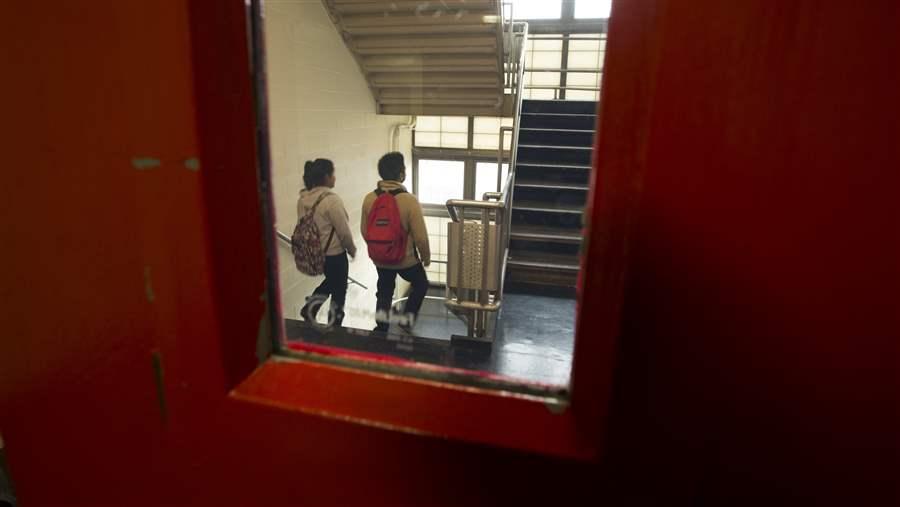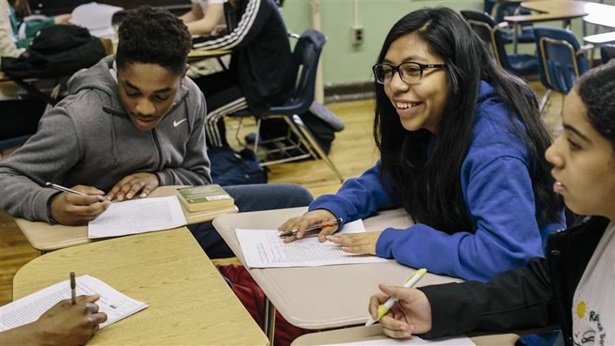Pew Examines High School Selection Process in Philadelphia
Report sheds light on which students attended 21 special admission programs
PHILADELPHIA—A new analysis by The Pew Charitable Trusts explores for the first time the process of matching eighth-graders with district-run high schools in Philadelphia, shedding light on which students ended up in 21 special admission programs—generally considered the most desirable of those run by the School District of Philadelphia.
“Getting Into High School in Philadelphia: The Workings of a Complicated System” examines demographic and other information on 16,790 eighth-graders who were seeking enrollment in a district-run Philadelphia high school for the 2015-16 school year. Three main elements influenced which of these students were accepted into the special admission programs: academic qualifications, especially Pennsylvania System of School Assessment (PSSA) test scores; student and parent/guardian participation in the application process, through which they selected the schools the students wanted to attend; and admission decisions made independently by administrators at individual schools..
Pew’s analysis found that other factors also influenced which students were admitted to the special programs:
- Some programs did not attract enough applicants with qualifying PSSA test scores and accepted students with lower scores in order to fill seats; in all, 11 percent of students accepted to special admission programs did not have the minimum test scores.
- Some students with qualifying test scores did not apply, turned down offers of admission, or, even after being accepted, did not enroll when the academic year began in September.
- Some neighborhoods sent fewer students to these programs than others. Enrollment was lower for students living in areas relatively far from (or not readily accessible by public transportation to) the special programs, including much of West Philadelphia, North Philadelphia, and Northeast Philadelphia. Enrollment was higher in the more affluent parts of Center City and Northwest Philadelphia.
The study shows that all of these elements resulted in ninth-grade student bodies in the special admission programs that were different from the district’s ninth-grade population as a whole:
- There were higher percentages of Asians and whites, and lower percentages of Latinos and African-Americans, in the special admission programs. Among all ninth-graders, 56 percent were black, 19 percent Latino, 14 percent white, and 7 percent Asian. In the special admission programs, 51 percent were black, 12 percent Latino, 16 percent white, and 17 percent Asian.
- There were lower percentages of low-income students in the special admission programs. Although individuals receiving federal poverty assistance accounted for 60 percent of all ninth-graders, they represented 51 percent of those in the special admission programs.
- There were more girls and fewer boys. In the district as a whole, 51 percent of ninth-graders were boys and 49 percent were girls. In the special admission schools, the figures were 41 percent boys and 59 percent girls.
- There were lower percentages of English language learners and of students receiving special education support due to learning difficulties or physical disabilities, in special admission schools than in the district as a whole.
“In Philadelphia, eighth-graders are not required to attend a particular high school; instead, they go through an application process similar to that of applying to college,” said Michelle Schmitt, a researcher with Pew’s Philadelphia research initiative and author of the report. “Philadelphia’s system for placing students in various high schools and programs, including the highly competitive special admission programs, is complex and potentially challenging for students and parents to navigate. We hope this report will help policymakers and parents understand both the process and its outcomes.”
For more findings and to read the full report, visit www.pewtrusts.org/phillyhighschooladmissions.
###
The Pew Charitable Trusts is driven by the power of knowledge to solve today’s most challenging problems. Pew’s Philadelphia research initiative provides timely, impartial research and analysis on key issues facing Philadelphia for the benefit of the city’s citizens and leaders. Learn more at pewtrusts.org/philaresearch.















